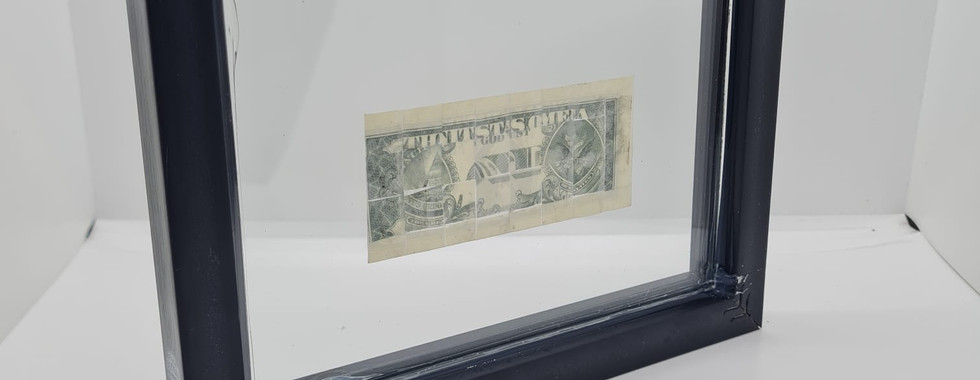Exploring My Relationship with the Almighty Dollar Through Art
- Rodrigo Méndez
- Feb 27, 2023
- 7 min read

As an artist, I've been exploring the role of the dollar in our world, both as a symbol of power and wealth and as a tool for shaping our economic and political systems. The dollar has played a central role in recent history, serving as a means of colonization and a weapon in global conflicts. It has also been a potent force for good, providing economic stability and financial aid in times of crisis.
The US dollar is a currency with a rich history that dates back to the 16th century. The origins of the dollar can be traced back to the Spanish silver coin known as the "Real de a Ocho," which was used as currency in Spain's New World colonies, including what is now the United States. The modern form of the dollar was established by the Federal Reserve Act of 1913, which created the Federal Reserve System and introduced the modern central banking system.
The US dollar has become known as the country's greatest weapon due to its role in global financial markets. As the world's dominant reserve currency, the dollar has been used to promote US economic interests and to impose sanctions on countries that do not comply with US foreign policy goals. The US government has also used the dollar as a tool for colonization, particularly in Central and South America.
One example of the dollar's influence in the region is the country of Panama. The US has a long history of intervention in Panama, starting with its financing and support of Panamanian independence from Colombia to build the Panama Canal. A year after independence, the United States government imposed the use of the dollar as the official currency of Panama as a means to stabilize the economy and maintain control of its investment.
Perhaps the most notorious intervention was the US invasion of Panama in December 1989, which resulted in the removal of Panamanian leader Manuel Noriega. The invasion was partly motivated by the US government's desire to protect the Panama Canal and maintain the dollar's dominance in the region. While this move provided a measure of stability to the country, it also had the effect of cementing U.S. control over the Panamanian economy. Using the dollar ensured that the country remained tied to U.S. economic policies and interests. To this day it limits the ability of the Panamanian government to pursue its own economic agenda.

*Picture of U.S. soldiers during Operation Just Cause in Panama circa December 1989
My Relationship with the dollar
In 1999, my family made the decision to leave our home country of Colombia and move to Panama. The reason behind our move was the instability caused by political turmoil, the war on drugs, and other events that were prevalent in Colombia at the time. My parents wanted us to grow up in a country that was safe, stable, and free from violence.
As a 7-year-old child, I did not fully comprehend the historic and political events that were taking place. Nevertheless, I still remember the overwhelming feeling of positivity and optimism regarding the future of Panama. Only a decade had passed since the US invasion, and later that year, the Torrijos-Carter treaty was set to come into effect. This treaty signified that the United States was ceding full control of the Panama Canal to the Panamanians. The anticipation of this transfer of power, combined with the prevailing sense of optimism, was so tangible that one could almost sense it in the very air.
Panama was about to experience a period of sustained economic growth and stability. This was largely due to the country's status as a major international trade hub, with the Panama Canal serving as a key transit point for goods and services moving between the Pacific and Atlantic oceans. The country's economy was also bolstered by a thriving services sector, including financial services and tourism, as well as a rapidly growing real estate market.
Panama's economy grew at an average rate of 6.7% per year between 2000 and 2010, which was one of the highest growth rates in the region. The country's low inflation rate and stable currency, the US dollar, further contributed to its economic stability. The government of Panama also implemented policies aimed at attracting foreign investment and promoting economic development, including tax incentives for foreign companies and the creation of special economic zones.

*A picture of Panama city by Thomas Wilkinson
As a result of these factors, Panama experienced a significant increase in foreign investment and trade during the first decade of the 2000s. The country's construction industry also experienced a major boom, with a number of large-scale infrastructure projects being undertaken, including the expansion of the Panama Canal and the construction of a new airport. This led to a rapid increase in employment and business opportunities and helped to improve living standards for many people, including me and my family.
Fast forward to after graduating from high school, I moved back to Colombia to pursue a degree in Visual Arts during the early 2010s. Although Colombia had made significant progress in the past decade, it was still facing a lot of the same issues. One of the challenges I faced while living in Colombia was dealing with the volatile currency, the Colombian peso (COP). Financial planning was difficult because it was hard to predict how much goods and services would cost in the future. This made budgeting challenging and, since the purchasing power of each dollar was more than double when converting dollars into pesos, I fostered a false sense of wealth, which deprived me of learning to be more financially responsible. Nevertheless, it was good to be on the good side of the dollar.
In 2016, I graduated and moved back to Panama, only to experience the negative effects of having the dollar as the main currency. This was due to the Panama Papers scandal, which exposed how the offshore account system was used to conceal illegal activities such as money laundering and tax evasion. Although this system was originally implemented by the United States in the 1970s, the US used its economic influence through the dollar to pressure Panama to crack down on Panamanian entities involved in the scandal. However, the US has continued to maintain a very similar system in Delaware, a state known for its lenient corporate laws. It appeared that the crackdown on Panama was motivated by the interests of highly indebted countries, rather than a genuine desire to combat illegal financial activities. This situation highlights the power dynamics and double standards at play in international finance, where powerful countries use their influence to shape the rules and enforcement of the system in their favor.
The Dollar in a post-pandemic world
The pandemic has accelerated the trend toward digital payments and highlighted the potential benefits of a cashless society. As more people work remotely and online shopping becomes increasingly common, the use of cash has declined. The pandemic has also led to increased government spending, which could lead to inflation and a decrease in the dollar's value.
In a post-pandemic digital world, the dollar may change in several ways. Cryptocurrencies such as Bitcoin and Ethereum have emerged as alternatives to traditional fiat currencies, and central banks worldwide are exploring the possibility of issuing their own digital currencies. A digital dollar could offer benefits such as lower transaction costs, increased financial inclusion, and improved security.
However, a digital dollar could also pose risks such as increased surveillance and a greater potential for cyberattacks. The digitalization of the dollar has made it easier for governments to monitor financial transactions, which can be used to crack down on individuals based on their political views. For example, there have been instances of banks closing accounts of individuals or organizations that support controversial causes or political views. This type of financial censorship threatens freedom of expression and can have a chilling effect on free speech, as individuals may feel afraid to express their opinions knowing that their financial transactions could be monitored and used against them.
Using the dollar as art
As an artist, I have been exploring my relationship with money, especially the US Dollar through my artwork. I've found that using physical dollar bills in my collage art has been a powerful way to explore the social and cultural significance of the currency.
By cutting up and reassembling physical dollar bills, I'm able to create new images and meanings that challenge the traditional associations and connotations of the currency. The act of cutting up and reassembling the bills highlights the fragility and impermanence of the currency, and raises questions about the value we assign to physical objects. As we move towards an increasingly digital world, it's important to consider the significance of physical objects like dollar bills, and to explore the ways in which they shape our social and cultural identities.
Another way I have explored the dollar is by pixelating the currency in my oil paintings. By breaking down the recognizable image of the dollar bill into individual pixels, I'm able to play with the viewer's perception of the currency. The pixelated effect gives the impression of a digital image, even though the medium I use is traditional oil paint on canvas. This technique blurs the line between digitality and physicality, highlighting the ways in which technology is becoming more intertwined in our world.
By using oil paint to create a digital effect, I aim to create a dialogue between the traditional techniques of the past and the digital technologies of the present. The result is a powerful commentary on the role of the dollar in our lives and the ways in which we assign value to the symbols that shape our world.
Through my art, I hope to continue exploring the complex relationship between money, power, and art. I hope to engage viewers in a dialogue about the power dynamics at play in our economic systems and to raise questions about the role of the dollar in shaping our world. Whether through digital explorations or physical collage work, the dollar is a powerful symbol that continues to shape our lives in countless ways, and it's up to us to explore its significance.
If you are interested in learning more about my art and my creative journey, be sure to subscribe to my blog. As a subscriber, you will receive exclusive access to new content and updates about my latest projects, as well as behind-the-scenes insights into my creative process.




























Comments